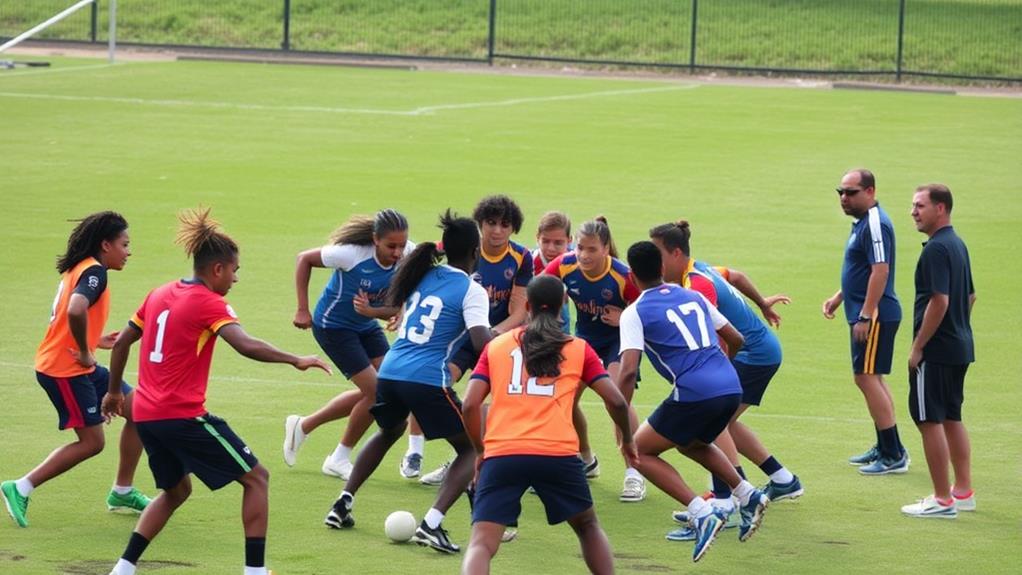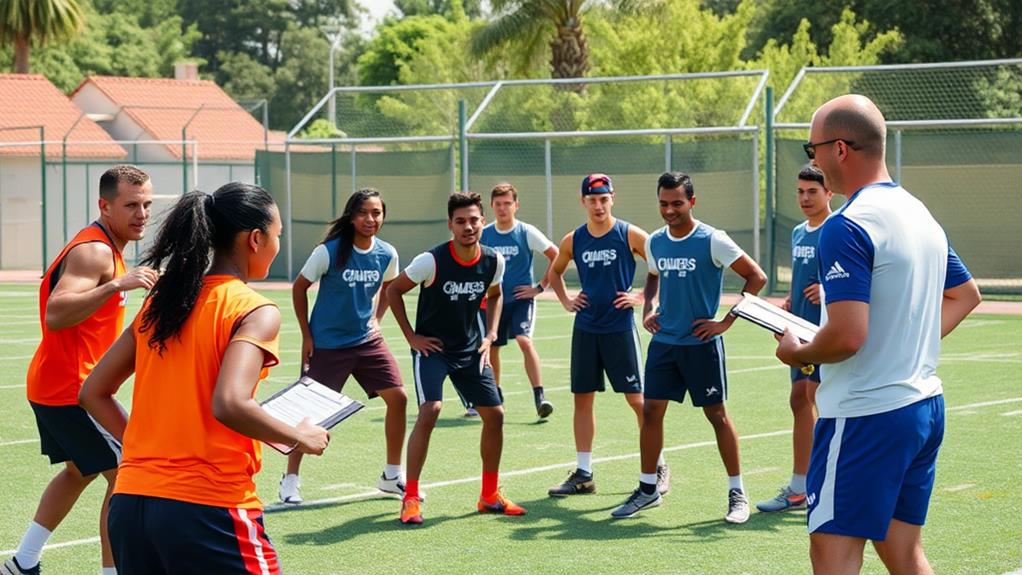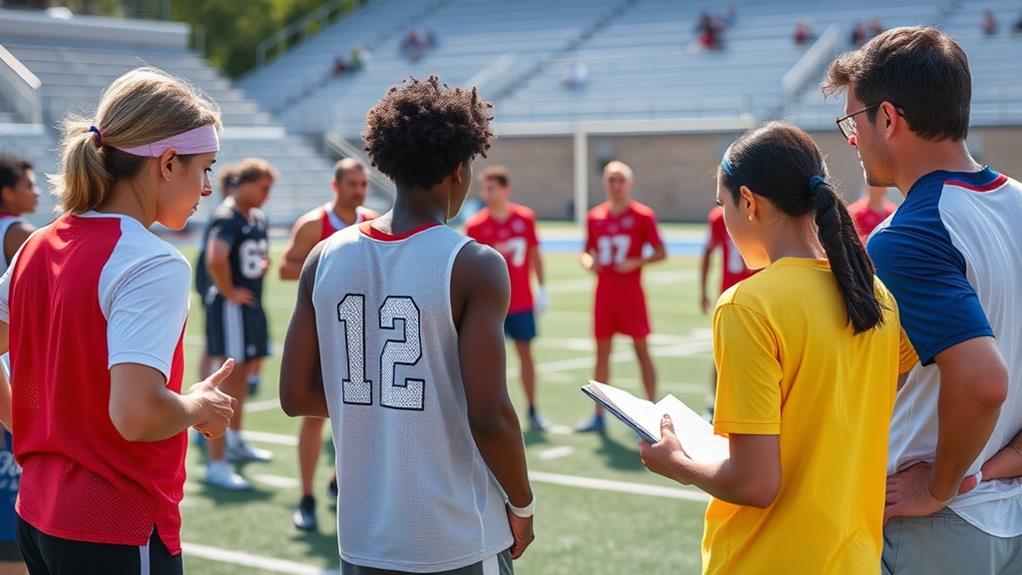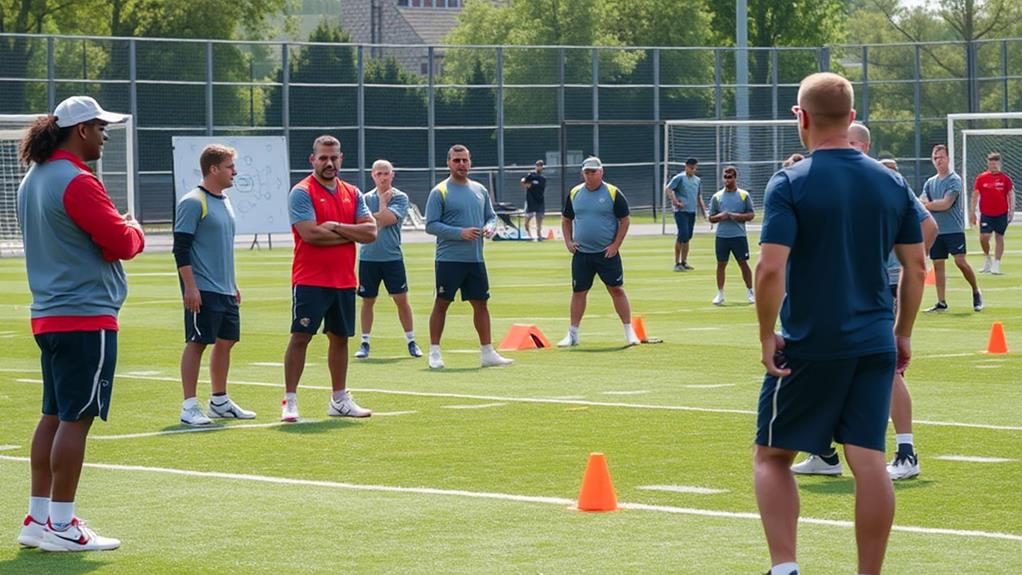
What Is a Scrimmage and How to Use It Effectively in Practice
September 30, 2024A scrimmage is a practice method that simulates real-game situations, helping you enhance your team's skills and understanding of tactics. It fosters teamwork and communication while allowing players to experience live conditions without the pressure of competition. To use scrimmages effectively, set clear objectives for skill development and structure your sessions with varying drills. Keep score to maintain engagement and encourage a competitive spirit. Regular reflection post-scrimmage can help reinforce learning and identify areas for improvement. Stick around to discover more techniques and tips for maximizing the benefits of scrimmages in your practices.
Understanding Scrimmages
Understanding scrimmages is essential for any player looking to improve their skills. A scrimmage helps you experience real-game situations without the pressure of competition. In this practice game, you can learn the rules, field positions, and game mechanics through practical application, deepening your understanding of the game. Just as the establishment of the Football Association in 1863 standardized soccer rules, participating in scrimmages allows players to familiarize themselves with the regulations of the game (standardizing soccer rules).
During scrimmages, coaches assign different teams and positions, allowing tailored coaching based on your performance. This focused approach helps you develop specific skills relevant to your role. Plus, the no-pressure environment encourages teamwork and communication among players, fostering a collaborative learning atmosphere.
Scrimmages typically last up to 90 minutes, providing ample time to practice various game scenarios and hone your abilities. You'll find that the more you engage in scrimmages, the more comfortable you become with game dynamics, strategies, and in-game decisions.
Ultimately, participating in scrimmages not only enhances your technical skills but also builds your confidence on the field. By embracing these practice games, you'll pave the way for significant growth as a player, ensuring you're better prepared for competitive play.
Benefits of Intrasquad Scrimmages
Intrasquad scrimmages are a great way to keep your team engaged and competitive during the season. They not only foster a spirit of competition but also help you understand and apply game strategies in real-time.
This hands-on approach can sharpen your decision-making skills, making you more effective on the field. Additionally, scrimmages provide an excellent opportunity to implement fundamental principles of defense and enhance communication among teammates, essential for cohesive gameplay.
Team Engagement and Competition
Scrimmages are an important part of keeping your team engaged and competitive during practice. By incorporating practice scrimmages into your routine, you foster a lively atmosphere that helps maintain high energy levels and enthusiasm among team members.
These scrimmages not only provide a break from monotonous drills but also serve as effective team-building exercises. When players compete against each other, they enhance camaraderie and trust, which can translate to better performance on the field.
Moreover, the competitive nature of intrasquad scrimmages guarantees that your players stay in game condition without solely relying on traditional practice methods. Engaging in these scrimmages allows athletes to apply their skills in a more dynamic setting, encouraging them to think critically and adapt quickly during gameplay.
This experience is vital for developing essential aspects of the game, such as positioning, decision-making, and teamwork.
Incorporating practice scrimmages into your team practice not only keeps players engaged but also promotes a healthy competitive spirit. It's a win-win situation that keeps your team motivated while enhancing their overall performance.
Real-Time Strategy Understanding
A well-executed practice scrimmage can transform how players grasp game strategies in real-time. By simulating live game conditions, you'll see improvements in your understanding of tactical decisions and positional responsibilities.
This hands-on experience is invaluable, allowing you to apply the skills and drills you've practiced in a competitive setting.
Here are some key benefits of intrasquad scrimmages:
- Enhanced Tactical Understanding: You can better comprehend offensive and defensive plays as you experience them firsthand.
- Motivation and Engagement: The competitive nature of scrimmages keeps players enthusiastic to improve their skills and work together as a cohesive unit.
- Tailored Coaching Insights: Coaches can identify individual strengths and weaknesses, leading to more focused training and strategic adjustments.
Intrasquad scrimmages not only boost your real-time strategy understanding but also foster camaraderie among teammates.
This improved communication and synergy can greatly impact your performance during actual games. By actively participating in scrimmages, you'll develop a deeper connection to the game, making you a more effective player on the field.
Effective Implementation Strategies

To make your scrimmage sessions truly effective, start by setting clear objectives for each practice.
This structure not only keeps players engaged but also helps them understand their roles and expectations.
Incorporating effective passing techniques during scrimmages will further enhance team dynamics and foster better communication.
Setting Clear Objectives
Establishing clear objectives for each scrimmage is essential for effective practice. When you focus on specific skills or strategies, you create a structured learning environment that enhances practice time.
Here are some strategies to help you set clear objectives:
- Communicate Roles: Before the scrimmage, make certain each player knows their responsibilities. This clarity helps everyone understand what's expected during gameplay.
- Monitor Performance: Keep an eye on how players are doing throughout the scrimmage. This allows you to identify areas that need improvement and adjust your coaching strategies as necessary.
- Encourage Reflection: After the scrimmage, prompt your players to reflect on their performance. This feedback loop reinforces learning and promotes development.
Incorporating these strategies not only motivates players but also fosters a competitive atmosphere.
Scorekeeping can enhance this effect by encouraging players to make their at-bats count.
Structuring Practice Sessions
Structuring practice sessions effectively can make all the difference in player development and team cohesion. Start by incorporating a variety of drills that focus on specific skills, ensuring scrimmages serve as a bridge between practice and competitive play. This approach not only enhances engagement but also helps players learn how to navigate game situations.
Set clear objectives for each session, including scrimmages, so players understand their roles and the intended outcomes. Utilizing controlled scrimmages allows you to provide real-time feedback, enabling immediate corrections and reinforcing learning in a game-like environment.
Adjust the duration of scrimmages based on your team's progress throughout the season. Begin with shorter sessions of 15-20 minutes, gradually increasing to 30 minutes as players become more comfortable with the pace and flow of the game.
Engaging Players Actively
Creating an environment that actively engages players during scrimmages is key to maximizing their development and enjoyment of the game. Here are some effective strategies to keep players involved and motivated:
- Utilize a 4-on-4-on-4 format: This promotes movement and understanding of game strategies while accommodating different team sizes based on your roster.
- Maintain a competitive atmosphere: Keeping score enhances the benefits of scrimmaging by motivating players to participate and improve their performance actively.
- Set clear objectives: Clearly defined roles and goals for each session help players understand expectations and focus on their learning.
Regularly assess player performance and encourage feedback during scrimmages. This practice allows you to monitor progress, make necessary adjustments, and foster ongoing development.
By engaging players actively, you create a dynamic environment where they can thrive. Remember, the more involved they are, the greater their enjoyment and growth in the game will be.
Implementing these strategies not only enhances the scrimmage experience but also contributes considerably to their skill development and love for the sport.
Skill Development Through Scrimmaging
Scrimmaging opens up a world of skill development for players, allowing them to gain invaluable experience in live game scenarios. By facing real-time pitching and defensive plays, you enhance both your offensive and defensive skills. This hands-on experience helps you identify your strengths and weaknesses, paving the way for targeted skill development and personalized coaching.
Incorporating defensive stance drills during scrimmages can further sharpen your agility and positioning, which are vital for effective defense.
Additionally, scrimmages create simulated-game conditions that enable you to adapt to various roles within your team. This adaptability not only fosters versatility but also deepens your understanding of team dynamics. As you practice in these game situations, you're faced with decision-making under pressure, reinforcing the skills you've learned from traditional drills.
Moreover, structured scrimmages promote teamwork and communication, both of which are essential for effective play and overall skill development. Engaging with your teammates in this way allows you to build chemistry, which translates to better performance during actual games.
Setting Practice Expectations

Establishing clear expectations for practice can greatly enhance the effectiveness of your scrimmage sessions. When you set these expectations, you create a focused environment where players can thrive and improve.
Incorporating conditioning drills, such as Pain Shuttles Drill, can further enhance endurance and agility during scrimmages.
Here are some key points to contemplate:
- Define Objectives: Establish clear objectives for each scrimmage, focusing on specific skills or strategies that will enhance player development and overall team performance.
- Communicate Roles: Prior to the scrimmage, communicate roles and expectations to your players. Ascertain they understand their responsibilities and what aspects of their performance will be evaluated.
- Structured Environment: Create a structured environment that balances competition with learning. This allows players to apply practice concepts in real-time scenarios.
Transitioning to Competitive Play
As you move from practice to competitive play, it's vital to recognize how scrimmages connect the gap between skill development and real-game scenarios. Engaging in scrimmages allows you to apply the skills you've honed during practice in a setting that mimics actual competition. This change is important, as it helps you translate your practice performance into effective game execution.
Incorporating speed and agility drills during scrimmages can further enhance your ability to maneuver on the field, making the experience more game-like. Scrimmages reinforce the skills developed throughout the season, ensuring that you're not just practicing in isolation but are prepared to implement those skills during matches. They also maintain team morale and foster a competitive spirit, which can greatly enhance your performance when it counts.
Moreover, scrimmages provide your coaches with valuable insights into your offensive and defensive strategies. By analyzing the outcomes, they can make targeted adjustments tailored for upcoming competitive situations.
This dynamic environment helps you mentally and physically prepare for the pressures of competitive play, ultimately boosting your confidence.
Coaching Techniques for Scrimmages

Moving from practice to competitive play requires effective coaching techniques during scrimmages to maximize learning and performance. To guarantee your players benefit the most, consider implementing the following strategies:
– Controlled Scrimmages: Actively engage with players by stopping play to address mistakes. This real-time feedback balances learning with enjoyment, making the scrimmage a constructive experience.
Additionally, consistent effort is essential for refining skills, so encourage players to embrace the learning process during these sessions.
- Set Clear Objectives: Before each scrimmage, outline specific skills or strategies for players to focus on. This clarity helps them understand their goals and what they're working towards.
- Rotate Positions: Allow players to experience different positions throughout the scrimmage. This not only provides insights into their strengths and weaknesses but also fosters a deeper understanding of the game.
Incorporating competitive elements like scorekeeping encourages players to make their at-bats and plays count.
As a coach doing the pitching, you can further promote a growth mindset by offering constructive feedback that highlights both positive actions and areas for improvement.
Resources for Coaches and Players
When it comes to enhancing your coaching and playing experience, numerous resources are available to support both development and enjoyment of the game. For coaches, tailored practice plans for youth baseball and softball are invaluable. These plans include specific drills focused on batting, fielding, and base running, empowering you to enhance your team's performance.
Incorporating essential skills and positions into your practice sessions can further improve player capabilities and teamwork on the field. You can also benefit from online resources and publications like "The Young Athlete's Guide to Playing Sports." These materials offer valuable tips and techniques to improve skills while making the game more enjoyable.
Engaging with the coaching community through forums and discussions allows you to share strategies and insights, creating a collaborative environment for player development. Utilizing instructional videos and articles can deepen your understanding of effective scrimmage formats and how to incorporate them into practice sessions.
Additionally, resources that emphasize teamwork and communication are essential for helping players develop critical skills during scrimmages, which ultimately boosts their game performance. By taking advantage of these resources, you'll be better equipped to create engaging practices that foster growth and enjoyment for both you and your players.
Conclusion
Incorporating scrimmages into your practice isn't just a game—it's a powerful tool for growth. By understanding their benefits and implementing them effectively, you can elevate your team's skills and readiness for competitive play. Remember, each scrimmage is a stepping stone, turning practice into a dynamic learning experience. So, embrace the chaos of scrimmaging, and watch your players transform into confident competitors, ready to take on any challenge that comes their way!


